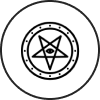Ostara is celebrated around March 21 for the Northern Hemisphere; September 21 for the Southern Hemisphere - Researched and Compiled by StormWing, ©1996 - 2023 StormWing
Ostara (pronounced "O-STAR-ah") is one of the Lesser Wiccan Sabbats and is celebrated on the Spring Equinox. The variance, as with all Solar festivals, is due to the differences between the actual astronomical event and our calendar, so be sure to check the calendar each year.
Other names this Sabbat is also called by are the Vernal Equinox or the Spring Equinox, Oestara, Eostres Day, Rite of Eostre, Equinozio della Primavera (Aridian Strega), Alban Eiber (Caledonii Tradition or the Druids), Bacchanalia, Festival of the Trees, and Lady Day. Christians celebrate their holiday - Easter - near this same time and it is based on basically the same principles as ours in the Old Religion. Easter is actually determined in a very Pagan manner... it is always the first Sunday after the first Full Moon after the Spring Equinox.
This Sabbat is a time to celebrate the arrival of Spring, when light and darkness are in balance but the light is growing stronger. The forces of masculine energy and feminine energy are also in balance and this day marks paves the way for the coming lushness of Summer. Ostara is a time for the celebration of fertility and balance, a time when all elements within and without us are brought into harmony. A time of new life and rebirth, as well as the end of Winter.
Symbols used to represent Ostara include the egg (for fertility and reproduction) and the hare (for rebirth and resurrection), the New Moon, butterflies and cocoons. Symbolically, many Pagans choose to represent Ostara by the planting of seeds, potted plants, ringing bells, lighting new fires at sunrise, either in the fireplace (if the weather is still cold enough), in the the cauldron, or light a balefire (if outdoors). I always give myself a gift of a newly potted plant or take a seed and plant it within my cast Circle. Ritually, a fire may be lit in the cauldron during (not before) the rite itself. You may want to decorate your altar with a colorful bouquet of Spring wildflowers. Other traditional activities include working on magickal gardens and practicing all forms of herbal work --- magickal, artistic, medicinal, culinary, and cosmetic.
Here is a traditional Vernal Equinox pastime according to Scott Cunningham: go to a field and randomly collect wildflowers. Thank the flowers for their sacrifice before picking them and it is also best to leave an offering to the plant and/or the Earth for taking the flowers, such as some milk and honey, a small crystal or even a coin. Or, buy some from a florist, taking one or two of those that appeal to you. Then bring them home and divine their magickal meanings by the use of books, your own intuition, a pendulum or by other means. The flowers you've chosen reveal your inner thoughts and emotions. A particular suggestion from Scott Cunningham that I really enjoy each year is to do the following... at this time in the turn of the Wheel of the Year, when all things are green and renewed life is all around us, it is a very good idea to plan a walk (or a ride) through gardens, a park, woodlands, forest and other green places. This is not simply for exercise, and you should be on no other mission. It isnt even just an appreciation of Nature. You should make your walk celebratory, a ritual for Nature itself. Other Pagan activities may include the planting of your herb and/or vegetable garden.
Another very popular Ostara activity is decorating and coloring or dying hard-boiled eggs - or other eggs such as wooden or paper mache (I call them "Ostara Eggs"), and drawing Pagan and magickal symbols on the colored eggs. You could then choose to either keep the eggs, bury them in the Earth or cast them into a fire as offerings to the Goddess - the choice is yours. If I use hard- boiled eggs, I usually bury them in the Earth when the ritual is over, but -alternately - here is my personal choice... I usually make my eggs from the paper mache ones (the cost factor comes in to play here, they are a LOT cheaper than the wooden ones, but the wooden ones are much smoother). I buy them at the local craft store. These eggs can be reused next year and you can even add new ones to the old, if you like. The first thing I do is paint them each a different color - whatever shade strikes me - whether it be dull, bright, pastel, or primary. Then I use gold and silver paint pens to draw Pagan designs and magickal symbols all over them. You may opt to use other color combinations. It is entirely up to your personal choice. I have one egg that is totally covered with interconnected triangles (Triple Goddess), a couple with pentagrams and God and Goddess symbols, some with words written in Theban script, etc. Just let your imagination take you there - its a lot of fun!
Appropriate Deities for Ostara include all Youthful and Virile Gods and Goddesses, Sun Gods, Mother Goddesses, Love Goddesses, Moon Gods and Goddesses, and all Fertility Deities. Some Ostara Deities to mention by name here include Persephone, Blodeuwedd, Eostre, Aphrodite, Athena, Cybele, Gaia, Hera, Isis, Ishtar, Minerva, Venus, Robin of the Woods, the Green Man, Cernunnos, Lord of the Greenwood, The Dagda, Attis, The Great Horned God, Mithras, Odin, Thoth, Osiris, and Pan.
Key actions to keep in mind during this time in the Wheel of the Year include openings and new beginnings.
Spellwork for improving communication and group interaction are recommended, as well as fertility and abundance. Ostara is a good time to start putting those plans and preparations you made at Imbolc into action. Start working towards physically manifesting your plans now.
The most common colors associated with Ostara are lemon yellow, pale green and pale pink. However, also appropriate colors include grass green, all pastels, Robins egg blue, violet, and white.
Stones to use during the Ostara celebration include aquamarine, rose quartz, and moonstone.
Animals associated with Ostara are rabbits and snakes. M
ythical beasts associated with Ostara include unicorns, merpeople, and pegasus.
Plants and herbs associated with Ostara are crocus flowers, daffodils, jasmine, Irish moss, snowdrops, and ginger.
For Ostara incense, you could make a blend from any of the following scents or simply choose one... jasmine, frankincense, myrrh, dragons blood, cinnamon, nutmeg, aloes wood, benzoin, musk, African violet, sage, strawberry, lotus, violet flowers, orange peel, or rose petals.
Foods in tune with this day (linking your meals with the seasons is a fine way of attuning with Nature) include eggs, egg salad, hard-boiled eggs, honey cakes, first fruits of the season, fish, cakes, biscuits, cheeses, honey and ham. You may also include foods made of seeds, such as sunflower, pumpkin and sesame seeds, as well as pine nuts. Sprouts are equally appropriate, as are leafy, green vegetables.
From Scott Cunningham: flower dishes such as stuffed nasturtiums or carnation cupcakes also find their place here. (Find a book of flower cooking or simply make spice cupcakes. Ice with pink frosting and place a fresh carnation petal on each cupcake. Stuff nasturtium blossoms with a mixture made of cream cheese, chopped nuts, chives and watercress.) Appropriate Ostara meat dishes should contain fish or ham.
May the Lord and Lady bless you all with fertility, abundance, success, and all things new!







